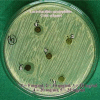Antimicrobial effects of Citrus sinensis peel extracts against dental caries bacteria: An in vitro study
- PMID: 26855710
- PMCID: PMC4739372
- DOI: 10.4317/jced.52493
Antimicrobial effects of Citrus sinensis peel extracts against dental caries bacteria: An in vitro study
Abstract
Background: Ethnomedicine is gaining admiration since years but still there is abundant medicinal flora which is unrevealed through research. The study was conducted to assess the in vitro antimicrobial potential and also determine the minimum inhibitory concentration (MIC) of Citrus sinensis peel extracts with a view of searching a novel extract as a remedy for dental caries pathogens.
Material and methods: Aqueous and ethanol (cold and hot) extracts prepared from peel of Citrus sinensis were screened for in vitro antimicrobial activity against Streptococcus mutans and Lactobacillus acidophilus, using agar well diffusion method. The lowest concentration of every extract considered as the minimal inhibitory concentration (MIC) values were determined for both test organisms. One way ANOVA with Post Hoc Bonferroni test was applied for statistical analysis. Confidence level and level of significance were set at 95% and 5% respectively.
Results: Dental caries pathogens were inhibited most by hot ethanolic extract of Citrus sinensispeel followed by cold ethanolic extract. Aqueous extracts were effective at very high concentrations. Minimum inhibitory concentration of hot and cold ethanolic extracts of Citrus sinensis peel ranged between 12-15 mg/ml against both the dental caries pathogens.
Conclusions: Citrus sinensispeels extract was found to be effective against dental caries pathogens and contain compounds with therapeutic potential. Nevertheless, clinical trials on the effect of these plants are essential before advocating large-scale therapy.
Key words: Agar well diffusion, antimicrobial activity, dental caries, Streptococcus mutans, Lactobacillus acidophilus.
Conflict of interest statement
Figures




Similar articles
-
Antimicrobial effects of citrus sinensis peel extracts against periodontopathic bacteria: an in vitro study.Rocz Panstw Zakl Hig. 2015;66(2):173-8. Rocz Panstw Zakl Hig. 2015. PMID: 26024407
-
Antimicrobial Effect of Jasminum grandiflorum L. and Hibiscus rosa-sinensis L. Extracts Against Pathogenic Oral Microorganisms--An In Vitro Comparative Study.Oral Health Prev Dent. 2015;13(4):341-8. doi: 10.3290/j.ohpd.a30601. Oral Health Prev Dent. 2015. PMID: 24046822
-
In vitro investigation of antimicrobial activities of ethnomedicinal plants against dental caries pathogens.3 Biotech. 2018 May;8(5):257. doi: 10.1007/s13205-018-1283-2. Epub 2018 May 14. 3 Biotech. 2018. PMID: 29765815 Free PMC article.
-
Use of an Extract of Indian Sacred Plant Ocimum sanctum as an Anticariogenic Agent: An in vitro Study.Int J Clin Pediatr Dent. 2015 May-Aug;8(2):99-101. doi: 10.5005/jp-journals-10005-1292. Epub 2015 Aug 11. Int J Clin Pediatr Dent. 2015. PMID: 26379375 Free PMC article. Review.
-
Plant-Derived Compounds: A Promising Tool for Dental Caries Prevention.Curr Issues Mol Biol. 2024 May 26;46(6):5257-5290. doi: 10.3390/cimb46060315. Curr Issues Mol Biol. 2024. PMID: 38920987 Free PMC article. Review.
Cited by
-
Thymus vulgaris L. and thymol assist murine macrophages (RAW 264.7) in the control of in vitro infections by Staphylococcus aureus, Pseudomonas aeruginosa, and Candida albicans.Immunol Res. 2017 Aug;65(4):932-943. doi: 10.1007/s12026-017-8933-z. Immunol Res. 2017. PMID: 28752199
-
Medicinal Plants Against Dental Caries: Research and Application of Their Antibacterial Properties.Plants (Basel). 2025 May 5;14(9):1390. doi: 10.3390/plants14091390. Plants (Basel). 2025. PMID: 40364419 Free PMC article. Review.
-
Physiochemical properties, dietary fibers, and functional characterization of three yuzu cultivars at five harvesting times.Food Sci Biotechnol. 2021 Jan 6;30(1):117-127. doi: 10.1007/s10068-020-00850-3. eCollection 2021 Jan. Food Sci Biotechnol. 2021. PMID: 33552623 Free PMC article.
-
Revisiting the Therapeutic Effects of Essential Oils on the Oral Microbiome.Pharmacy (Basel). 2023 Feb 10;11(1):33. doi: 10.3390/pharmacy11010033. Pharmacy (Basel). 2023. PMID: 36827671 Free PMC article. Review.
-
Phytochemical Screening and In Vitro Antifungal Activity of Selected Medicinal Plants against Candida albicans and Aspergillus niger in West Shewa Zone, Ethiopia.Adv Pharmacol Pharm Sci. 2022 Jun 28;2022:3299146. doi: 10.1155/2022/3299146. eCollection 2022. Adv Pharmacol Pharm Sci. 2022. PMID: 35800399 Free PMC article.
References
-
- Hotwani K, Baliga S, Sharma K. Phytodentistry: use of medicinal plants. J Complement Integr Med. 2014;11:233–51. - PubMed
-
- Mehmood B, Dar KK, Ali S, Awan UA, Nayyer AQ, Ghous T. Short communication: in vitro assessment of antioxidant, antibacterial and phytochemical analysis of peel of Citrus sinensis. Pak J Pharm Sci. 2015;28:231–9. - PubMed
-
- Akdemir Evrendilek G. Empirical prediction and validation of antibacterial inhibitory effects of various plant essential oils on common pathogenic bacteria. Int J Food Microbiol. 2015;202:35–41. - PubMed
Publication types
LinkOut - more resources
Full Text Sources
Other Literature Sources
